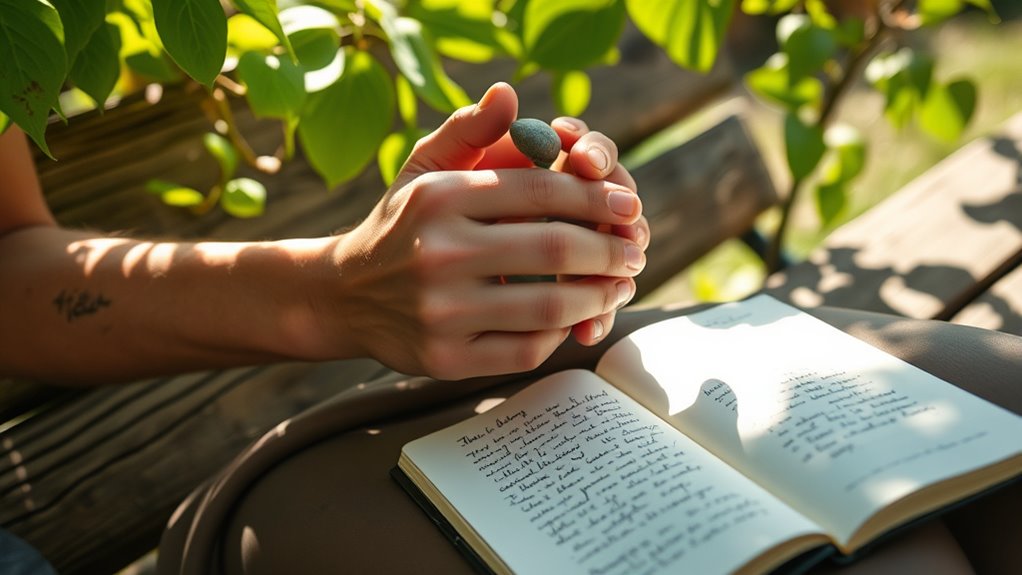When emotional storms hit, grounding techniques help you stay present by using your senses to reconnect with the here and now. Focus on tactile sensations like holding a textured object, take slow breaths, or notice details around you to reduce overwhelm. Incorporating movement or listening to calming sounds can also help. Developing a routine with these strategies strengthens your resilience. If you want more ways to manage intense emotions, explore further techniques and tips.
Key Takeaways
- Use sensory techniques like touching textured objects or feeling temperature changes to redirect focus and calm emotions.
- Focus on visual details in your environment, such as colors or natural elements, to anchor yourself in the present.
- Listen to calming sounds or nature recordings to reduce anxiety and enhance emotional regulation.
- Practice breathing exercises like box breathing or diaphragmatic breathing to activate the relaxation response.
- Incorporate movement and physical activities, such as stretching or mindful walking, to reconnect with your body and stay grounded.
Understanding the Role of Grounding in Emotional Regulation

Understanding the role of grounding in emotional regulation is essential, especially if you’re managing intense feelings or trauma. Grounding techniques help you stay present during emotional distress by anchoring you in the physical world. When emotions feel overwhelming, these strategies shift your focus from internal chaos to what’s around you—touching objects, noticing sounds, or observing your surroundings. They reduce feelings of being overwhelmed and promote emotional stability. For people with BPD, who often experience heightened emotional reactivity, grounding offers a way to manage these storms and regain control. By helping you stay rooted in the present, grounding fosters resilience and emotional balance. It’s a practical tool that supports other therapies and self-care practices, making emotional regulation more achievable during challenging moments. Additionally, incorporating anime movies with emotional depth can provide comforting distraction and insight during difficult times. Recognizing the emotional regulation strategies involved in grounding can also enhance your overall coping skills. Using sensory awareness can further deepen your connection to the present moment and strengthen your grounding practice. Engaging in holistic practices like mindfulness and holistic care models can complement grounding techniques and promote overall well-being.
Sensory-Based Grounding Techniques to Calm the Mind

You can calm your mind by focusing on engaging touch sensations, like holding textured objects or feeling temperature changes. Visual focus strategies, such as identifying colors or shapes around you, help ground you in the present moment. Listening to calming sounds or acknowledging specific noises also reduces anxiety and increases awareness. Incorporating sensory-based techniques can enhance your ability to stay present during emotional storms. Additionally, understanding how air purifier technology supports overall health can promote a sense of well-being, making emotional regulation easier. Recognizing the importance of environmental considerations can further reinforce a calming routine during stressful times. Being aware of special occasions that celebrate resilience and spiritual strength can serve as motivating reminders of hope and community support.
Engaging Touch Sensations
Engaging touch sensations are a powerful way to ground yourself during emotional distress. Holding textured objects like smooth stones or fabrics redirects your focus to tactile feelings, anchoring you in the present. These sensations stimulate sensory receptors, reducing dissociation and calming your mind. Temperature-based touch, such as holding a warm mug or cold ice, activates your nervous system and enhances body awareness, helping manage emotional flooding. Applying firm pressure through squeezing a stress ball or pressing your feet to the floor engages proprioception, reducing anxiety. Gentle skin-to-skin contact, like stroking your arms, releases oxytocin and promotes safety, interrupting negative spirals. Use the table below to explore these techniques and find what works best for you. Additionally, engaging the sense of touch can be especially beneficial for individuals with sensory processing impairments, as it helps them re-establish a connection with their body and environment during overwhelming moments. Incorporating neuroscience insights can deepen your understanding of how sensory input influences emotional regulation. Research shows that incorporating sensory-based techniques can significantly improve emotional regulation and provide immediate relief during intense episodes. Moreover, choosing appropriate textures can enhance the calming effect during tactile grounding practices. Exploring different texture qualities may help you discover the most soothing sensations for your personal needs.
Visual Focus Strategies
Visual focus strategies are effective tools for grounding and calming the mind during emotional distress. You can start by observing your surroundings and cataloging visual details, which helps anchor your attention in the present moment. Noticing colors and textures around you engages your senses and distracts from overwhelming feelings. Observing elements of nature, like trees, clouds, or flowers, can soothe your mind. Recognizing visual patterns, such as shapes or designs, shifts your focus away from distressing thoughts. You might also count objects in your environment, creating a simple distraction. Incorporating these techniques with mindfulness enhances awareness and helps you stay present. Adjusting lighting, reducing clutter, or viewing calming visuals like water or landscapes can further promote a sense of calm and stability during emotional storms. Engaging with visual details stimulates the brain’s sensory pathways, further grounding techniques you in the present moment and reducing distress. Exploring visual sensory stimulation, such as fabric textures or patterns, can also serve as a calming visual focus, helping to anchor your attention. Additionally, understanding the divorce process and requirements can reduce stress when dealing with legal issues. Incorporating portable calming tools, such as small visual aids or calming images, can also assist in grounding during intense emotional episodes.
Auditory Calm Techniques
Building on visual focus strategies, auditory calm techniques offer another effective way to ground your mind during emotional distress. These techniques use sound to anchor you in the present, helping reduce anxiety and manage auditory hallucinations. You can listen to nature sounds, calming music, or white noise, which shift your focus away from overwhelming feelings. Research indicates that auditory stimulation can influence emotional regulation processes. Incorporating sensory-based grounding techniques can further enhance your ability to stay present and centered. Guided mindfulness sessions lasting around 10 minutes can deepen your practice, often with external recordings for convenience. Combining sound with breathing exercises or meditation enhances emotional regulation and helps reframe negative beliefs about voices or distress. These methods are adaptable for both private and public settings, making them accessible anytime you need a quick mental reset. Regular use boosts resilience, offering calming relief during emotional storms. Using calming sounds can also activate your parasympathetic nervous system, promoting relaxation and stress reduction. Additionally, paying attention to the recurring patterns of sounds can deepen your connection to the present moment and further support emotional stability. Incorporating sound therapy techniques can enhance the calming effects and provide additional mental clarity, especially when combined with understanding air purifier features and technology for a healthier environment.
Breathing and Movement Strategies for Immediate Relief

When emotions run high, quick and effective breathing and movement strategies can help you regain control. Resonance frequency breathing slows your breath to about five seconds per inhale and exhale, boosting heart rate variability and calming your nervous system. Techniques like box breathing and the 4-7-8 method create a balanced pattern that counters tension and hyperventilation, providing rapid relief during emotional storms. Diaphragmatic breathing engages your parasympathetic nervous system, lowering heart rate and increasing awareness of your body. Humming bee breathing releases tension in your face and jaw while stimulating the vagus nerve for relaxation. Movement-based strategies, like muscle relaxation combined with slow breathing, shift your focus from overwhelming emotions to physical sensations, helping you stay present and grounded in moments of crisis. Resonance frequency breathing trains effective deep breathing by slowing to 10-12 breaths per minute, which can enhance emotional regulation by modulating your breathing pace. Incorporating technology-assisted methods may further improve your ability to stay centered during intense emotional episodes. Additionally, practicing mindfulness techniques during these moments can reinforce your capacity to remain present and reduce emotional reactivity. Breathing techniques like resonance frequency breathing can optimize your autonomic nervous system, making it easier to manage emotional storms. Practicing body awareness techniques can also deepen your connection to physical sensations, further supporting emotional stability.
Cognitive Approaches to Maintain Presence and Clarity

Cognitive approaches are powerful tools for maintaining presence and clarity during emotional distress. They help redirect your focus and interrupt spirals of intense feelings. For example, naming all visible objects shifts your attention outward, grounding you in the environment. Describing steps for familiar activities engages your memory, pulling you away from intrusive thoughts. Counting backwards from 100 by 7 challenges your concentration, anchoring your mind in the present. Describing an object in detail taps into your senses, enhancing awareness. Spelling names backwards demands mental effort, breaking emotional patterns. Here’s a quick reference: Research supports that these techniques can effectively reduce emotional overwhelm by engaging different cognitive pathways.
| Technique | Focus Area | Example |
|---|---|---|
| Name visible objects | External environment | “Tree, chair, window” |
| Describe familiar steps | Memory and process | “Making tea, brushing teeth” |
| Count backwards | Concentration | “100, 93, 86” |
| Describe an object in detail | Sensory awareness | “Red, rough, heavy” |
| Spell backwards | Mental effort | “John – nhoj” |
Recognizing Triggers and Building Self-Awareness

Have you ever wondered what triggers your intense emotional reactions? Recognizing these triggers is key to managing your responses. Common triggers include feelings of separation, rejection, or abandonment, which can lead to emotional storms. Relationship events like breakups or criticism often intensify your symptoms, while external stressors such as life changes or traumatic events can also spark episodes. Everyone’s triggers are different, so paying close attention helps build awareness. Track your emotional responses, behaviors, and patterns to identify recurring situations or people that set off your reactions. Using journals or apps can help you notice trends and warning signs. Developing self-awareness through education, mindfulness, and reflection allows you to better understand your emotional landscape and prepare for challenging moments. Recognizing these triggers can also help you implement preventive strategies to reduce the impact of emotional storms.
Incorporating Grounding Into Daily Routines

Incorporating grounding techniques into your daily routines can provide consistent support for managing intense emotions. You might start by using sensory activities, like sipping mint tea or smelling lavender, to stay connected to the present. Touch-based grounding, such as holding smooth stones or fabrics, can help calm your nerves. Naming objects around you enhances visual focus, and listening to calming sounds or nature helps regulate your mood. Physical activities like short walks, stretching, or mindful breathing can reconnect you with your body. Adding mindfulness practices such as meditation or gratitude exercises strengthens your emotional resilience. Schedule these activities regularly, set reminders, and integrate them into daily tasks like eating or showering. Consistency makes grounding a natural part of your routine, fostering stability during emotional storms.
Combining Grounding With Professional Support

Integrating grounding techniques into therapy provides a structured way to manage intense emotions associated with BPD. When you work with a therapist, they can teach you how to shift your focus from overwhelming feelings to the present moment using sensory awareness and mindfulness. This approach helps interrupt emotional cascades triggered by interpersonal stressors, which are common in BPD. Physical grounding methods like breathing exercises and sensory engagement work alongside cognitive strategies to improve emotional regulation. Your therapist creates a safe environment to practice these skills, making it easier to apply them outside sessions. Support from professionals also involves psychoeducation for your loved ones, fostering understanding and a collaborative approach. This partnership enhances your ability to use grounding techniques effectively, promoting stability and resilience.
Tips for Strengthening Your Grounding Practice Over Time

Building a consistent routine helps make grounding a natural part of your day. Trying new techniques keeps your practice fresh and effective, while seeking support from others provides encouragement and accountability. Together, these strategies strengthen your grounding skills over time.
Consistent Routine Practice
Establishing a consistent routine is key to strengthening your grounding practice over time. Set specific times each day for your exercises, like after brushing your teeth or before meals. Use reminders or alarms to prompt you, making it easier to stick with your routine. Start with brief sessions of one to five minutes, then gradually increase their duration as you become more comfortable. Linking grounding to daily activities helps it become a natural part of your life. Track your sessions in a journal or app to monitor progress and stay motivated. Incorporate grounding into progressions, like arriving home or starting work, and keep tools accessible to reduce barriers. Consistent practice builds resilience and makes grounding a reliable coping strategy during emotional storms.
Explore New Techniques
Exploring new grounding techniques can deepen your ability to stay present during emotional storms. Trying different methods keeps your practice fresh and effective. For example, engaging your senses by tasting herbal tea, listening to calming music, or smelling essential oils grounds you in the moment. Progressive muscle relaxation helps release tension, while visualization transports you to a peaceful place. Incorporating mindfulness exercises, like body scans or mindful movement, enhances awareness. Physical activities, such as walking or yoga, deepen your connection to bodily sensations. Use the table below to explore various techniques and find what resonates with you:
| Technique | Focus Area | Example |
|---|---|---|
| Sensory Engagement | Senses | Smelling lavender oil |
| Progressive Relaxation | Muscle Tension | Tensing and relaxing muscles |
| Visualization | Imagination | Imagining a calm beach |
| Mindfulness Exercises | Present Moment | Deep breathing |
Seek Support Systems
Strengthening your grounding practice over time becomes more effective when you actively seek support from trusted individuals and resources. Building a support network with family and friends provides emotional reassurance and encouragement during difficult moments. Working with mental health professionals helps you develop personalized grounding strategies tailored to your needs. Joining support groups focused on BPD or trauma offers shared insights and new techniques. Engaging with online communities and forums can supplement your support system, giving you access to advice and understanding around the clock. Additionally, crisis hotlines are essential for immediate assistance during intense emotional episodes. By consistently connecting with these resources, you reinforce your grounding habits, build resilience, and create a dependable foundation for managing emotional storms more confidently over time.
Frequently Asked Questions
Can Grounding Techniques Replace Professional Therapy for BPD?
You might wonder if grounding techniques can replace professional therapy for BPD. The truth is, they can’t. Grounding offers immediate relief during emotional crises, but it doesn’t address the complex underlying issues like emotional instability and relationship challenges. Professional therapies like DBT or schema therapy target these root causes, helping you develop lasting skills. Relying solely on grounding limits your progress; extensive treatment is essential for meaningful change.
How Quickly Do Grounding Methods Typically Reduce Emotional Overwhelm?
Think of grounding methods like flipping a switch—they can often bring rapid relief. Usually, you’ll notice a decrease in emotional overwhelm within minutes, especially if you’ve practiced the techniques regularly. Some might feel calmer almost instantly, while others need a few minutes. It varies based on your familiarity with the method and the intensity of your feelings. Keep practicing, and over time, you’ll find these tools become quicker and more effective.
Are There Specific Grounding Tools Recommended for BPD Management?
You’re asking about specific grounding tools recommended for BPD management. To help you stay present, try using sensory-based tools like a textured stress ball or scented candle to engage your senses. Incorporate mindfulness practices such as deep breathing or body scans. Physical activities like gentle walking or stretching can also help. Keep supportive items nearby, like reminder notes or a comforting blanket, to make grounding easier during emotional storms.
How Often Should I Practice Grounding Techniques for Best Results?
Think of practicing grounding techniques like watering a plant—you need consistent care to see growth. You should aim for daily practice, especially during calm moments, to strengthen your skills. When emotions surge, use grounding exercises multiple times a day if needed. Flexibility is key; adapt your routine to your symptoms. Regular, brief sessions build resilience, helping you stay rooted even in the stormiest emotional weather.
Can Grounding Help During Intense Emotional Episodes or Only in Calmer Moments?
You’re wondering if grounding can help during intense emotional episodes or just in calmer moments. It definitely works in the heat of emotional storms, helping you stay present and reduce impulsivity. When emotions run high, grounding techniques like deep breathing or sensory focus can slow your mind and body, giving you a vital pause. Practice these skills regularly so they become a reliable tool whenever emotions surge, providing immediate relief and stability.
Conclusion
So, now you’re basically a grounding superhero in the making—minus the cape (unless you want one). Remember, staying present isn’t about perfect control, but about catching yourself before the emotional storm turns into a full-blown hurricane. Keep practicing these techniques, and soon, you’ll be calmly sipping your tea while chaos brews around you. Who knew that staying grounded could turn you into the calmest person in the room? Cheers to your emotional resilience!









